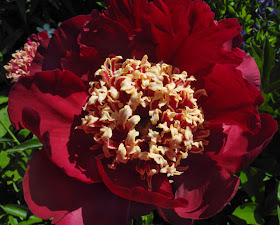I am lucky to have grown up in a Syrian Jewish household, with a mother who is a brilliant cook. The traditional foods she serves are truly delicious: all kinds of stuffed vegetables, various kibbehs in sauces with vegetables, and other good things. A recipe for stuffed onion rolls is here; for bazargan, which is an appetizer made with bulgar and tamarind paste here; for zucchini, cheese and egg pie here; rice and lentils with caramelized onions, mujedrah, here. Sweets are one of the glories of the Middle Eastern kitchen; there are various elegant pastries, among which is baklava. But one of my favorite desserts since childhood is the unusual pudding called Al Mazieh, simply made with cornstarch, sugar, and water, and flavored with rose water and added nuts. It is a translucent jelly which tastes as though you are eating a floral perfume.
I served this to friends last week, who loved it, so felt encouraged to share the recipe for the adventurous. It's very easy to make.
1 cup cornstarch
2 scant cups sugar
9 cups water
2 Tbs rose water
1/2 cup blanched and peeled almonds
1/2 cup blanched and peeled pistachios (note: my cousin Poopa Dweck, in her beautiful cookbook The Aromas of Aleppo, uses 1 cup each of almonds and pistachios. That's too many nuts for my taste, but you can certainly use that many, or amounts in between.)
- In a large, heavy bottomed saucepan mix together the cornstarch, sugar, and water, stirring until the cornstarch and sugar are completely dissolved.
- Cook over medium high heat, stirring often, until the mixture comes to a slow boil.
- Reduce heat and simmer, stirring frequently, until the mixture thickens and coats a spoon, about 1 hour.
- Add the rose water and the nuts and stir well.
- Pour into a 2 quart non-stick mold, or into a glass bowl. The jelly is so pretty that you don't want to hide it in a ceramic bowl. Refrigerate for at least 2 hours until it is firm.
- To unmold, loosen the sides of the jelly from the mold, put a platter on top and turn over (hoping for the best; mine came out quite well, with only a couple of imperfections).
**Speaking of family, I'll be away visiting my family for a few days, so I'll see you next week.























































